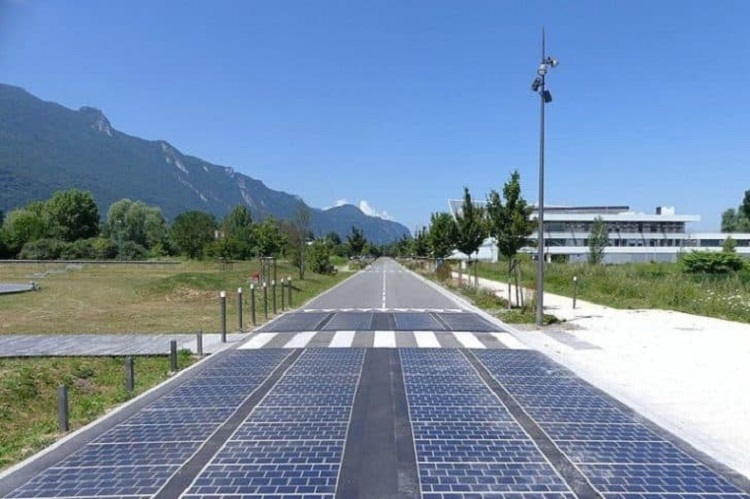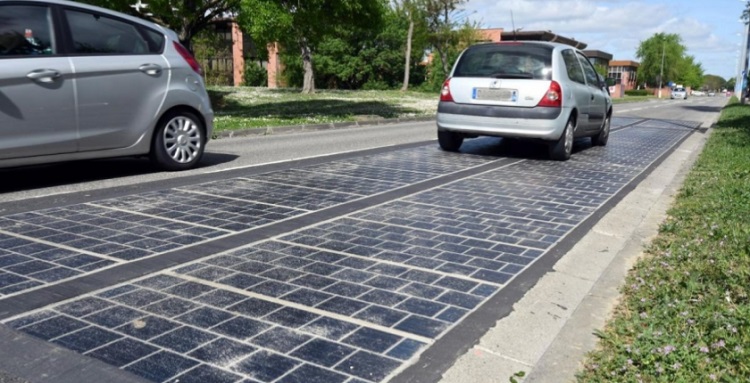
Roadways are constructed from a variety of materials, including concrete, tarmac, asphalt, cement, and more. In order to take advantage of green energy sources, some items are getting a makeover. The operation of solar highways looks like this. In order to power these "solar highways," solar photovoltaics are employed.
Solar panels or photovoltaic cells cover the road's surface. The shift aims to generate energy from roads, which cover 0.5% of the earth's surface, and improve driving. Residential streets, driveways, and parking lots also use the system.
While the practical implementation of solar highways can be complicated, the idea itself is straightforward. These roadways are actually "paved" with glass-encased solar panels that are both incredibly durable and able to sustain the constant weight of passing automobiles.
In 2014, when the first Solar Roadways, Inc. initiative emerged (and is still looking for funding), the concept generated a lot of buzz: solar-powered roads with integrated LEDs for indicating lanes, communicating with motorists, and other purposes were included in more sophisticated designs. Earlier versions of such devices included road obstruction detectors and driveway intrusion alarms based on weight sensors. Including this new idea in the images of solar roads made them look more appealing and helped to get people excited about them at first.
Solar roadway pioneers promoted their benefits. These:
Electrify
Solar roadways use panels to generate solar power. The electricity can light nearby streets and roads. Location, driveway orientation, and shading affect how much electricity is generated.
Busy highways may not generate much electricity because vehicles block the sun. Since most cars aren't at home during the day, solar driveways would generate a lot of power. Solar highways will be important for charging electric cars as they gain popularity.
Green Energy
Solar panels are known for producing clean energy. Due to climate change, scientists advocate switching to renewable energy from fossil fuels. Solar highways would help save the earth and reduce climate change.
High-Tech Roads
Solar highways employ advanced technologies. Include heating for the road. They're installed similarly to regular block paving, with the blocks forming an even surface. Only broken blocks are removed and replaced, making repairs easy and economical.
High-tech Features are Helpful
In damp and freezing places, high-tech elements like heating the road are essential. The panels' heat may melt ice and snow to clear roads. They also make roads and paths safe for driving after winter, cold weather, or severe rains.
Road Lighting
Not all roads, especially in rural areas, are lit. Road illumination is expensive and unnecessary in low-traffic areas. Solar roads lower the cost of lighting these places.
Solar lamps charged by solar roadways can light roads at night. LED lights along the road use solar electricity to indicate the path and make the driveway self-sufficient. Well-lit and well-signposted highways make nighttime driving less stressful.
Helps Neighbors
Solar roadways have built-in pressure sensors and detectors to prevent crime. These sensors warn homeowners when someone is on their route or drive.
Sensors alert a homeowner to the presence or arrival of guests and critical service providers like postal delivery. Assuming four hours of sunlight per day, one mile of solar road panels can power 428 houses.
Durable
Solar roads are durable, like ordinary driveways. They're weatherproof, durable, and can carry a lot. They require no special care or cleaning. Weeding and resealing a standard driveway will be the same.
Multipurpose
Solar energy can be used for more than just heating and lighting. Solar roadways can generate electricity in locations without grid access. It can also distill water in locations with limited supplies. It powers space spacecraft. Solar panels can also be put together to make green energy windows that are clear and made of solar energy.
Low-maintenance
Solar roads require equal or less upkeep than ordinary roads. Clean them twice a year to keep them clean. When in doubt, get a cheap specialist. Most solar panel manufacturers provide 20-year warranties.
There are no moving parts, so there is no wear. Only the inverter needs to be replaced every 5–10 years. For best efficiency, cables need upkeep. Solar highways can be problematic, as discussed below.
Safety
Solar road developers say solar tiles make roadways safer. The claims haven't been tested with real cars on real roads. They've tried using bikes and a pendulum rig. This doesn't account for spilled oil or rain. Even if the panels have been tested, it's uncertain if they can endure traffic.
Placement
Solar panels are slanted to capture as much sunlight as possible. Unluckily for solar highways, the panels will have to be placed horizontally, which isn't the most productive angle. Shading implies less electricity is produced, and only a tiny portion of the panel generates power.
Performance Decline
The panels' location and installation can reduce their energy output. They're road-mounted, preventing airflow.
The panels will generate much more heat than rooftop panels. Every degree Celsius above optimal temperature results in a 5% reduction in energy efficiency. This causes the panels' performance to decline, reducing their ROI.
This requires a lot of money, as well as knowledge, inverters, batteries, and wiring. The Watt Way in France, launched in 2016, cost €5 million for 1 km of solar panels.
Only Certain Places Can Install Them
Some highways run through forests, tunnels, or towers. These structures or habitats block sunlight from reaching the road; therefore, solar highways in these regions won't produce enough electricity. They can only be installed in certain places, notably in direct sunshine.
Fragility
Rooftop solar panel installation is more difficult than roadside solar panel installation. Solar panels are fragile and must be protected when paved on roads. These materials reverberate more than ordinary ones, causing noisy driving. Unlike roof solar panels, road solar panels must be even and have joiners. This can weaken structures.
Solar Panels are Fragile
unstable solar panels. Excess strain or weight on the panels can damage the electronic systems and cause the system to fail. Durability on roadways will command a fortune.
For traction, roads are frequently built of asphalt and gravel. Transparent solar panels lack traction.
Costly Solar Highways
To resist vehicle weight, solar panels need thicker glass, which reduces light absorption. Solar roadways have substantial installation and maintenance costs that aren't offset by power generation. Solar farm upkeep and installation are cheaper. Solar farms generate more power.
Installing solar panels on high buildings is cheaper. The panels can be arranged for maximum efficiency. Renewable energy systems must be economically viable. Wind, solar, and hydropower farms are preferable options. They're cheap and quick ways to produce renewable energy.
Daytime LED Visibility is Poor
Solar Roadways promised LEDs that would replace road paint. The lights must be visible without being excessively power-hungry.

The proliferation of solar roadways around the globe over the past five years indicates they are the way of the future.
France: As previously reported, in 2016, the world's first solar road, a 1 km stretch of asphalt in Tourouvre-au-Perche, France, was constructed. A solar road covering around 2,880 square meters was used to generate enough electricity to run the neighborhood's streetlights.
Georgia, USA: A trial section was set up close to the Alabama–Georgia state line because its implementation in France was so successful. The Ray Project, a 29-kilometer "living laboratory" for the study of renewable energies and technology, is where the Ray C. Anderson Foundation conducted this pilot test.
China: In 2018, a kilometer of expressway was constructed in Jinan, China. It can produce about 1,000,000 kWh annually. But soon after the building was finished, some of the panels were stolen. These panels didn't have any value, so they were probably taken for reverse engineering.
Netherlands: It's possible to power three homes with the solar energy created by a 70-meter bike route in the Netherlands' Kilometers neighborhood. This path employs solar panels to generate between 50 and 70 kWh per square meter over the course of a year. Users have reported that they cannot tell the difference between the surface and standard tarmac.
Despite these obstacles and others, solar technology continues to advance. Solar panels have become more durable, cost-effective, and efficient since the first solar roads. To quantify:
Technological advances are being made all the time. Modern humanity thrives on innovation. Though there are many great ideas, solar roadways designed for cars are probably not one of them.
The design is far too expensive, unreliable, and does not work. With the technology available today, it is not feasible to design such a project. Instead of using time and money to develop impractical science projects, real advances could be made, like funding functional solar farms that are proven to work.
Perhaps in the future, there will be a material that can withstand the stresses of traffic and produce electricity. That time, however, is not now. The idea is incredibly cool, but unfortunately, it is also entirely impractical.
Also, a big thank you goes out to those who are willing to constructively criticize extravagant claims. Without criticism, science cannot progress. It is great to think outside the box; however, it is also important to invest time in more practical solutions. Albeit a great idea, it is an idea that just cannot work—not yet, that is.